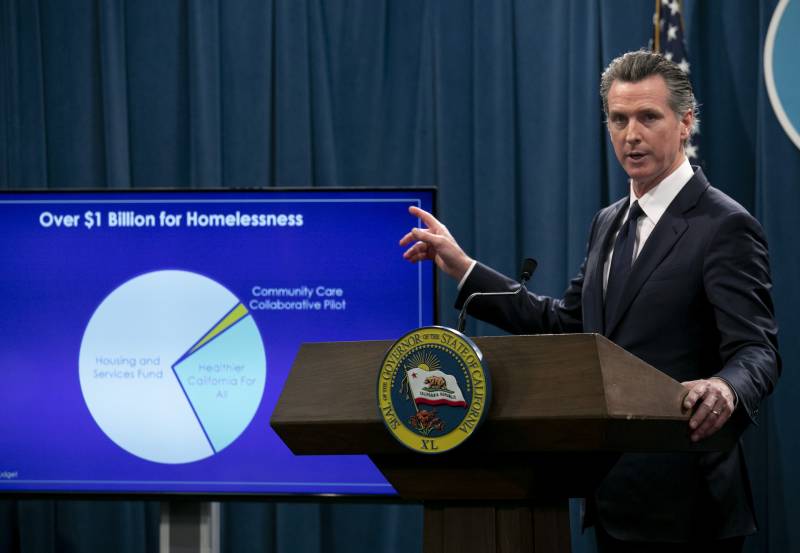The council’s recommendation stops short of Steinberg’s and Ridley-Thomas’ initial call for a “right to shelter,” which would not only have required cities to provide immediate beds, but also obligated people experiencing homelessness to come inside. But it adds momentum to the strategy of elevating litigation as a tool to accomplish what compassion and money haven’t been able to do.
Newsom, visiting a homelessness program in Nevada County, said Monday he “would lean in the direction” of speedily deploying a legal “obligation” to supply sufficient services and housing, adding that “a number of cities and counties” have volunteered to do demonstration projects over the next several months, “not the next few years.” (Ridley-Thomas later said he would propose such a pilot in L.A. County this week.)
“I broadly have been encouraging this debate about obligations,” the governor said, adding that “there’s a distinction between rights and obligations.”
Without elaborating on that distinction, he seconded the task force’s point that many of the state’s responsibilities stem from legal mandates: “We do it in almost every other respect,” Newsom said. “On this issue we don’t, and I think that’s missing. The question is how do you do it ... . This is not black and white. This is tough stuff.”
Municipalities made it clear they would need more clarification.
“A legally enforceable mandate can only work with clarity of who’s obligated to do what and what new sustainable resources will fund it; that’s the ticket for clear expectations and accountability,” said Graham Knaus, executive director of the California State Association of Counties, in a statement.
Steinberg, meanwhile, called Monday’s proposal an improvement on the original “right to shelter” concept, saying a mandate by any name would still have the force of law. The point, the mayor said, is to give the courts a legal “last resort” to address pleas to supersede political gridlock, just as federal laws have in the past armed judges to combat other social crises. “It’s analogous to desegregation,” Steinberg said.
The task force’s proposal would let a “designated public official” sue the government for not doing enough to offer emergency and permanent housing to the homeless. A judge could then intervene to force a city to approve an emergency shelter, for example, or redirect budget funds to homelessness services.
The proposal, however, so far lacks specifics on how taxpayers would pay for such a mandate. The letter released by the task force, which includes local elected officials from large and small cities, states that “more state resources will undoubtedly be required” but includes no estimate.
State and local governments in recent years have poured billions into combating homelessness, only to watch the problem worsen as ever-rising rents drive Californians to the streets faster than they can be re-housed. On Friday, for the second straight year, Newsom proposed more than $1 billion in new state funds to fight homelessness, calling it “the issue that defines our times” in California. But the state’s “point-in-time” homeless count jumped 17% between 2018 and last year.
San Diego County Supervisor Nathan Fletcher, a task force member, said leverage is needed.
“We do the things we are required to do first ... then for everything else we try very hard,” Fletcher said. “Absent a legally enforceable obligation, I believe people will continue to try very hard.”
But a legal mandate would arm jurisdictions to tackle “the underlying problem which is poverty,” rather than appease communities with shelter beds, he said.
Putting the Onus on Government
Steinberg and Ridley-Thomas floated the idea of a statewide “right to shelter” law last year. Spurred by decades-old litigation, New York state has a “right to shelter” policy that makes its state and local governments legally liable for having emergency shelter beds available for every unhoused person.
While many credit “right to shelter” for New York’s success in reducing the number of people sleeping on the streets, Newsom and advocates for the homeless have balked at the idea. Some advocates fear it would divert finite funding from permanent supportive housing, which experts say is a more long-term, albeit expensive solution; others worry about cost and potential civil liberties violations that might arise from requiring a homeless person to accept shelter if it’s available.

